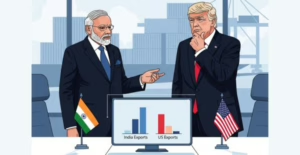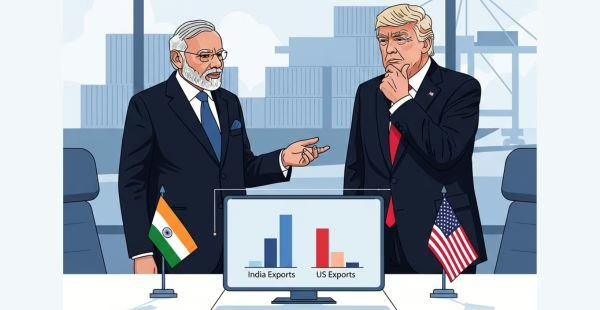
Disclaimer
This article is for informational purposes only and does not constitute financial or investment advice. The content is based on publicly available data as of August 13, 2025. Readers should consult qualified professionals for personalized guidance.
The relationship between the United States and India continues to evolve in the context of global trade and geopolitics. As of August 13, 2025, the U.S. administration announced new Trump tariffs on India on certain imports. According to official statements, these tariffs were introduced to address trade imbalances and broader foreign policy considerations. These developments may have effects on India’s export sectors and overall economic growth. This article provides an overview of the situation based on recent data and expert analyses.
The Introduction of Additional U.S. Tariffs
On August 6, 2025, the U.S. administration issued an executive order imposing an additional 25% tariff on certain imports from India. According to U.S. statements, this action relates to India’s purchases of Russian oil, which the United States has indicated may affect international efforts regarding Moscow. The tariffs were scheduled to take effect 21 days after the order and follow an earlier 25% levy implemented on August 1, 2025. A post on President Trump’s Truth Social account mentioned concerns about India’s trade policies and highlighted specific sectors affected by the tariffs.
These measures form part of the broader trade policy approach of the United States. Reports indicate that the initial measures followed bilateral trade discussions in which certain sectors, including agriculture and dairy, were points of negotiation. The U.S. Census Bureau reported a goods trade deficit of approximately $45.8 billion with India in 2024, which is a key factor in the discussion of the India U.S. trade deficit 2025. Some high-value exports, including pharmaceuticals, semiconductors, and electronics, were exempted from the tariffs, which may help maintain a portion of India’s trade with the United States. Observers note that trade measures continue to play a role in diplomatic and economic relations between the two countries.
India-U.S. Trade Deficit and Economic ContextImpact of U.S. Tariffs on Indian Exports
The trade deficit between India and the United States has been a focus of policymakers for several years. In fiscal year 2025, India exported goods worth approximately $86.5 billion to the United States, while importing around $45.3 billion, resulting in a goods trade surplus for India. Including services, India’s net surplus with the U.S. rises to around $44.4 billion, though estimates vary when accounting for education and digital services. Analysts note that the bilateral trade relationship has expanded over recent years, with India’s strengths in IT services and pharmaceuticals contributing significantly to exports.
While the trade imbalance remains an ongoing discussion point, the U.S. administration has cited average tariff differences as part of its justification for new duties. According to reports, India’s average tariff rate is around 12%, compared to 2.2% in the United States. Tariffs on certain Indian exports form part of a broader strategy to address perceived imbalances while maintaining diplomatic and economic engagement. These developments may have implications for India GDP growth impact 2025, as trade costs and market access influence economic forecasts.
Sectors Potentially Affected by Tariffs
Certain sectors that are labor-intensive and involve many MSMEs may experience increased costs and reduced competitiveness. Textiles and apparel, which export around $10.9 billion to the United States, could face higher duties that may affect profit margins and employment in key clusters. Gems and jewelry exports, valued at approximately $9.9 billion, may also encounter challenges. Auto components, chemicals, and marine products such as shrimp could experience additional tariffs, which may influence pricing and market dynamics. Engineering goods and metals, including steel and aluminum, may be affected by existing and additional duties.
Some sectors are exempted from the new tariffs. Pharmaceuticals and electronics are among the key exempted categories, which could help maintain India’s market presence in high-value and specialized goods. Analysts suggest that sectors not exempted could experience temporary delays in orders and increased competition from countries with lower tariffs, such as Vietnam. This highlights the Indian export sectors affected by tariffs and the need for businesses to adapt their strategies. Companies may also consider rerouting shipments through other countries, which could involve additional compliance considerations.
Estimated Impact on Exports and Businesses
Estimates indicate that the tariffs could reduce India’s U.S. exports by approximately $8.1 billion, representing a small portion of global merchandise exports. MSMEs may face increased challenges, and some employment impacts are possible in certain export hubs. Rising costs could affect competitiveness, and buyers may explore alternatives in countries with lower tariffs. In the short term, orders may be delayed, while long-term strategies include diversifying to markets in the EU, ASEAN, and Africa.
A weaker rupee may provide partial relief for certain sectors, particularly for exempt categories such as IT services. Analysts note that while export rerouting strategies are being considered, these may introduce additional operational and compliance complexities. The impact of U.S. tariffs on Indian exports could be significant for affected sectors, but India’s large domestic market and diversified export portfolio may help limit systemic economic disruption.
Implications for GDP and Economic Growth
Before the introduction of new tariffs, forecasts for India’s FY26 GDP growth were around 6.5%. Moody’s Analytics revised its estimate to 6.1%, noting potential effects on sectors such as gems, medical devices, and textiles. The PHDCCI projects a smaller impact of approximately 0.19%, emphasizing domestic demand and market diversification as mitigating factors.
The IMF’s July 2025 outlook maintained a growth projection of 6.4%, supported by strong performance in electronics and agri-food sectors. ANZ suggested a possible reduction of 0.4 percentage points if tariffs continue. The RBI may consider further rate adjustments to support consumption amid moderate inflation. Geopolitical developments, including India’s energy imports from Russia, add some uncertainty, while policy initiatives such as production-linked incentive schemes and free trade agreements with the UK and EU could help offset potential losses. These factors are critical in assessing the India GDP growth impact 2025 and trade resilience.
India’s Strategic Response
India’s response to these developments is multifaceted. Diplomatic engagement aims to negotiate a bilateral trade agreement to address outstanding issues. Support for MSMEs may include interest subventions and export promotion initiatives. Diversification of export markets toward Africa, Latin America, and other regions is being actively pursued. NITI Aayog has identified sectors that could gain competitive advantages, including agri-tech, renewable energy, and electric vehicles.
While short-term challenges may include reduced exports and order delays, structural reforms and domestic policy measures may support resilience. India’s broader economic strategy emphasizes balancing trade engagement with sovereignty and long-term growth priorities.

